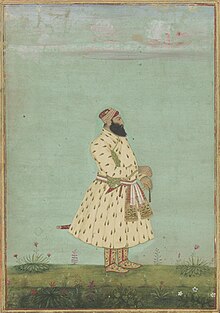WIKI.Safdar_Jang
-
Title WIKI.Safdar_Jang Short Title WIKI.Safdar_Jang Author Wikipedia Publisher Wikipedia Call Number https://en.wikipedia.org/wiki/Safdar_Jang Repository WIKI.EN Source ID S30 Linked to सफदरजंग मनसूर अली
-
Safdar Jang Nawab of Awadh
Khan Bahadur
Mir Atish
Firdaus Aaramgah[a]
2nd Nawab of Awadh Reign 19 March 1739 – 5 October 1754 Predecessor Saadat Ali Khan I Successor Shuja-ud-Daula Born 1708 Died 5 October 1754 (aged 45–46)
Sultanpur, Kingdom of AwadhBurial Spouse Nawab Sadar Jahan Ara Begum nee (Sadr-un-Nisa Begum) Names Abul Mansur Mirza Muhammad Muqim Ali Khan Safdar Jang House Nishapuri Branch of the Qara Qoyunlu Father Siyadat Khan (Mirza Jafar Khan Beg) Mother sister of Saadat Ali Khan I Religion Shia Islam Wazir-ul-Mamalik-e-Hindustan Asaf Jah Jamat-ul-Mulk Shuja-ud-Daula Nawab Abul Mansur Khan Bahadur Safdar Jang Sipah Salar (c. 1708 – 5 October 1754), better known as Safdar Jang, was the second Nawab of Kingdom of Awadh succeeding Saadat Ali Khan I (his maternal uncle and father-in-law) in the year 1739. All future Nawabs of Awadh were patriarchal descendants of Safdar Jang. He was a major political figure at the imperial Mughal court during the declining years of the Mughal Empire.
Biography
He was a descendant of Qara Yusuf of the Qara Qoyunlu confederation. In 1739, he succeeded his father-in-law and maternal uncle, Burhan-ul-Mulk Saadat Ali Khan I to the throne of Awadh/Oudh and ruled from 19 March 1739 to 5 October 1754.[citation needed] The Mughal Emperor Muhammad Shah gave him the title of "Safdar Jang".[1]
Safdar Jang was an able administrator. He was not only effective in keeping control of Awadh, but also managed to render valuable assistance to the weakened Emperor Muhammad Shah. He was soon given governorship of Kashmir as well, and became a central figure at the Delhi court. During the later years of Muhammad Shah, he gained complete control of administration over the whole Mughal Empire. When Ahmad Shah Bahadur ascended the throne at Delhi in 1748, Safdar Jang became his Wazir-ul-Malik-i-Hindustan or Prime Minister of Hindustan. He was also made the governor of Ajmer and became the "Faujdar" of Narnaul. In 1748, Javed Khan, a rival invited the new Nizam of Hyderabad Nasir Jung, to join an alliance against the wazir. Safdar jung requested Maratha support against Nasir Jung. Balaji Baji Rao dispatched Scindia and Holkar chiefs to prevent Nasir Jung's forces from reaching Delhi, and thus, saved Safdar jung.[2] In 1752, the Rohillas of the Doab region rebelled against the Mughal emperor. Safdar jung crushed the rebellion with Maratha support. However, court politics eventually overtook him and he was dismissed in 1753.[1] He returned to Oudh in December 1753 and selected Faizabad as his military headquarters and administrative capital. He intervened on behalf of Madho Singh of Jaipur in his conflict with Marathas and convinced the Marathas to leave with an apology and some compensation. He died in October 1754 at the age of 46 years in Sultanpur near Faizabad.[1]
Safdar Jang had maintained a contingent of 20,000 "Mughaliya" cavalry, most of whom were Hindustani Muslims, many who were chiefly from the Jadibal district of Srinagar in Kashmir, who had imitated the Qizilbash in dress and spoke the Persian language.[3][4] The state also saw a large migration of Kashmiri Shi'as to the Shi'a kingdom of Awadh, both to escape persecution and to secure courtly patronage.[5] This was especially the case with men from the district of Jadibal in Kashmir, who were all Shias, who looked to Safdar Jang as the sword-arm of the Shi'as in India.
Tomb

Safdar jung's tomb in Delhi Safdar Jang's Tomb was built in 1754 and is situated on a road now known as Safdar Jang Road, in New Delhi.[6]
Several other modern structures near the tomb also carry his name today like Safdar Jang Airport and Safdar Jang Hospital.
See also
Notes
- ↑ Title after death.
References
- 1 2 3 HISTORY OF AWADH (Oudh) a princely State of India by Hameed Akhtar Siddiqui
- ↑ G.S.Chhabra (2005). Advance Study in the History of Modern India (Volume 1: 1707–1803). Lotus Press. pp. 29–47. ISBN 978-81-89093-06-8.
- ↑ Sarkar, Jadunath (1964). Fall Of The Mughal Empire Vol. 1. digitallibraryindia; JaiGyan. p. 254.
- ↑ Srivastava, Ashirbadi Lal (1933). textsThe First Two Nawabs Of Oudh (a Critical Study Based On Original Sources) Approved For The Degree Of Ph. D. In The University Fo Lucknow In 1932.
- ↑ Hakim Sameer Hamdani (2022). Shi'ism in Kashmir:A History of Sunni-Shia Rivalry and Reconciliation. Bloomsbury. ISBN 9780755643967.
- ↑ "Safdar Jang Tomb Garden". Archived from the original on 27 September 2007. Retrieved 28 March 2007.
External links
 Wikimedia Commons has media related to Safdarjung.
Wikimedia Commons has media related to Safdarjung.- Indiacoins has an article on Safdar jung here
- Tomb of Safdar jung
This information is sourced from Wikipedia, the leading online open-content collaborative (crowd-sourced) encyclopedia. Wikipedia and/or TransLiteral Foundations can not guarantee the validaity of content above and can not be held responsible for inaccuracies or libelious information within. Please see Wikipedia General Disclaimer.




Comments | अभिप्राय
Comments written here will be public after appropriate moderation.Like us on Facebook to send us a private message.